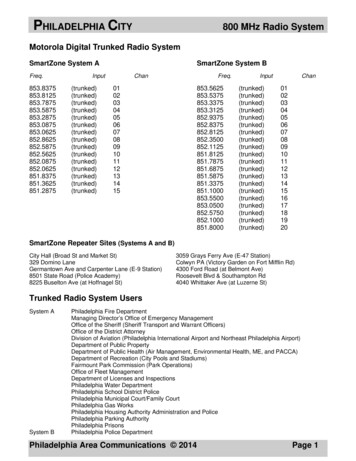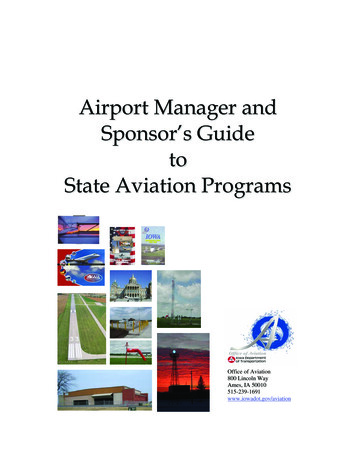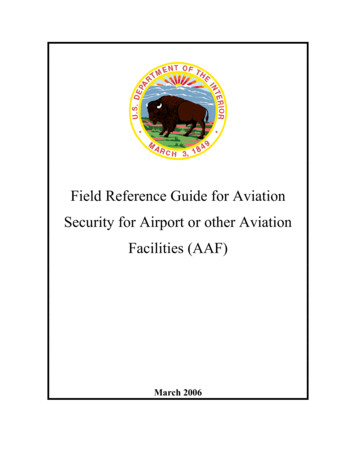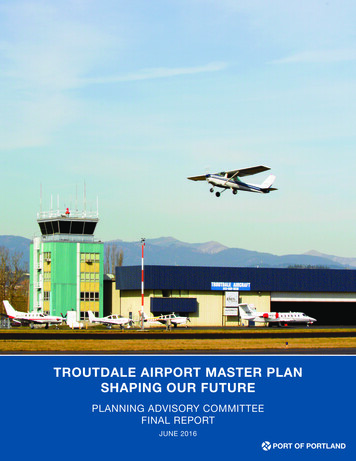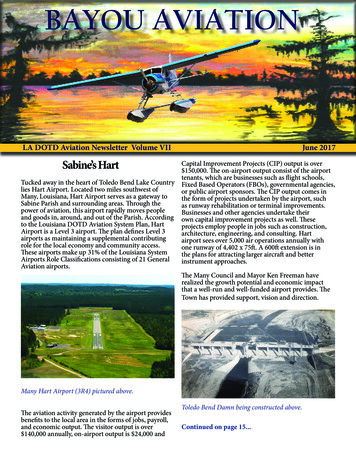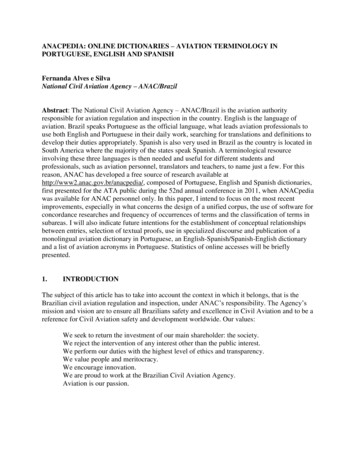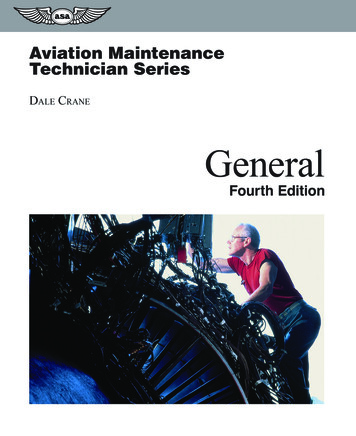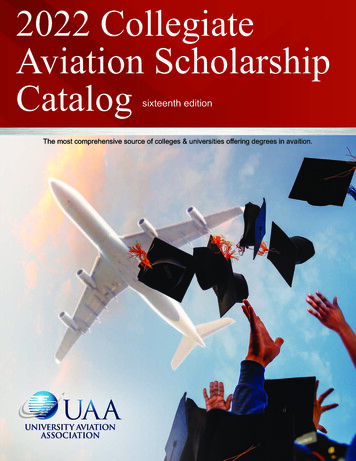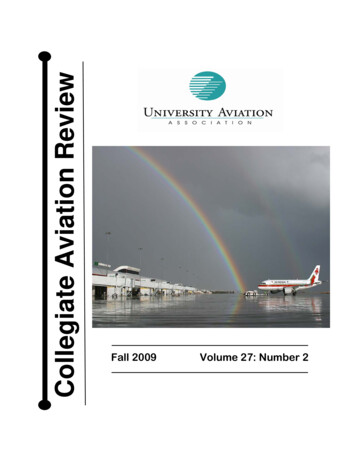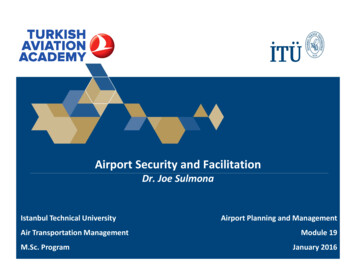
Transcription
Airport Security and FacilitationDr. Joe SulmonaIstanbul Technical UniversityAir Transportation ManagementM.Sc. ProgramAirport Planning and ManagementModule 19January 2016
OutlineA. IntroductionB. Security Management PrinciplesC. Airport Security PlanningD. Security-Oriented Facility DesignE. Airport Facilitation and CoordinationF. ConclusionJanuary 20162
Introduction
IntroductionJanuary 20164
National Security Realities Airports just another business– Typical risks like property theft, hackers seekingintellectual property, and staff corruption– Demands typical crime-prevention response likedoor locks, cyber protection, and integrity audits Airports face sovereignty related costs withlittle relationship to transport business– Border control and national security protectionscomplicate airport operations, especially forinternational flightsJanuary 20165
National Security Realities Peaceful now, but future attacks ongoing riskJanuary 20166
Privatization Complicates National Security Strategic (geo-political) target– Threat to aviation not bound by geographic limits– Air transport represent huge political target,whether privatized or remain in state hands– Violent acts introduce uncertainty, affectingsafety, security and regularity of air transport– Aviation security protocols undermine theindustry’s value proposition– Encourages travellers / shippers to use more userfriendly alternative modes where practicalJanuary 20167
Other Modes Starting to Face Similar ScrutinyJanuary 20168
Airport Management Strategy Better coordinated response needed– Facilitation vital to remove national securityobstacles to travel within and between states– Facilitation measures necessary to retain aviationindustry speed advantages or industry will wither– State directives to protect national securityinterests will not disappear anytime soon– Collaboration will reduce delays, administrativeexpenses, and improve customer curity/videoJanuary 20169
Security Management Principles
Enterprise Risk Management Airport Security Framework– Risk from operations createadverse outcomes leading tocosts and system failures– ERM process to identify andassesse risk– Need strategy to implementactions that mitigate, monitor,or control probability, andaccompanying adverse effectof un-desirable eventsJanuary 201611
Enterprise Risk ManagementIdentify Relevant RisksAssess Scope of Risk EventsIdentify Impacts Associatedwith Risk EventsMechanisms to Transfer, Mitigate, or AvoidRisksEstimate benefits, costs and externalitiesassociated with Transfer/Avoidance strategyImplement Enterprise RiskMitigation Strategy (includingrisk retention)January 2016Assess Performance / Modify ERM12
Aviation Security Perspectives ICAO Annex 17 Requirements– “Combination of measures, regulations,practices and procedures to safeguard civilaviation against acts of unlawful interference,taking into account the safety, regularity andefficiency of air travel”– State may delegate security functions to airportentities, aircraft operators, and local police– State to determine which costs for securityfacilities and services should be borne by theState, airport, or other responsible agenciesJanuary 201613
Aviation Security Perspectives IATA Position– First and foremost, state responsible for security– Governments should assess and provide costeffective solution for security measures– Provide airlines with adequate and transparentfinancial information– Consult airlines on security measures at a givenairport and on the level of security charges– Airports and airlines should agree a fair shareallocation of costs to ensure that all users make acontribution towards security costsJanuary 201614
Airport Management Relevance Crucial to Airport Business Continuity– Allocation of resources and organizationalaccountabilities to respond and recover– Capital markets require risk management toensure cash flow continuity / bond coverage– Requires specific Board and Executive levelgovernance / oversight structures– Corporate Social Responsibility integration IATA / ACI signed in 2013 Memorandum ofUnderstanding to jointly develop SmartSecurity (SmartS)January 201615
Airport Security Planning
Security Planning Model “Swiss Cheese” Risk Model– No single security application is 100% effective– Layered and stratified system reduces threatpenetrationJanuary 201617
Security Planning Model “Swiss Cheese Model” by J. Reason (1990)– Hypothesis that non-standard events traced toorganizational failures, but if dealt pro-activelywould reduce fault occasions and severity– Cheese holes represent individual systemweakness that continually vary size and location– System produces failures when holes alignpermitting "trajectory of accident opportunity" sohazard freely passes through all defences– ICAO adopts Reason model, and recommendsfirms organize defences through series of barriersJanuary 201618
Airport Security Practice Security Management System (SEMS)– Holistic approach to security intended topermeate the entire organizational structure,consistent with Annex 19, Safety Mgmt System– Performance-based and established againstcarefully evaluated threats– Fully structured yet flexibly designed to respondto changing needs– Widespread introduction remains work-inprogress, although no alternative approach wouldappear superior at presentJanuary 201619
Airport Security Practice Integrate process across value chain– Closer cooperation and common objectivesinvolving all relevant stakeholders– Encourage states to share information in timelymanner, without duplication, to identify advancethreats so appropriate risk management strategy /tactics can be employed– Information technology solutions to reduce costsand delivery global solutions across partners– Focus where insufficient data, but maintain somedefences for “Known” traveller / shippersJanuary 201620
Known Shipper / Traveler ProgramsJanuary 201621
Security-Oriented Facility Design
ICAO Related Obligations Annex 17, Standard 3.2.6– “Each Contracting State shall ensure thearchitectural and infrastructure requirements for theoptimum implementation of security measures areintegrated into design and construction of newfacilities and alterations to airports”– Privatized airports, through concession or nationallaw must be obliged in all circumstances to complywith security rules in compliance with ICAO, treatyobligations, and national practice– Creates uncertainty and undermine project viabilityJanuary 201623
Security Design Principles Design Fundamentals– Demarcation of secure airside and groundsideareas through designation of security accessrestrictions– Protection of barriers between access points– Recognize that each type of airport developmentmay have unique security requirements– Establish protocols for segregation of passengers,and possibly staff that require screening beforeaccess permitted to sensitive areas, increasinglyinvolving flight crewsJanuary 201624
Security Design Principles Design Fundamentals– Mitigate impacts of weapons use within thebuilding on passengers, staff, and buildingintegrity– Design core structural elements to limit impactsand casualties from post-attack structural failure– Require construction materials and assemblytechniques resilient to anticipated threat events– Enhance protection for vulnerable or high threatareasJanuary 201625
Security Design Principles Design Fundamentals– Integrate security designs in building fabric so toavoid conflicts between efficient use of passengerprocessing areas and system flow requirements,including facilitation, and commercial services– Recognize failure to adopt balanced approach canlead to having security requirements overwhelm orseriously interrupt passenger and staff flows– Permit contingency plan implementation so thatnon-affected building areas remain generallyusable to avoid total operational system failureJanuary 201626
Security Design Principles Complementary Requirements– Permit access for merchandise delivery throughoutbuilding without onerous costs to operators– Enhanced lighting and CCTV for surveillance– Recognize special arrangements will complicatesecurity access protocols (e.g. diplomatic baggage,prisoners and deportees under armed escort)– Social equity concerns demand service levels todisabled and mobility impaired travelers must beequivalent to standard process requirements Accommodation versus EquivalenceJanuary 201627
Security Design Principles Industry Consultation Really Not Optional– New build or renovations require conceptualdesign study well before detailed constructionplans and tender documents prepared to ensuresecurity elements are sufficiently addressed– Requires collaboration between security agencies,airport managers, building architects throughoutthe building planning process– Attention to anticipated future security / bordercontrol facility design standards will assist inplanning practiceJanuary 201628
Security Planning Criteria Security Design Manual– Numerous advantages toincorporating security intoairport planning at earliestplanning and design phase– Timely consideration ofsuch needs is almostguaranteed to result in costeffective, less obtrusive,and more effective andefficient security systemsJanuary 201629
U.S. TSA Facility Planning Topics Overview– Introduction– Applicability– Purpose– Background– Coordination– Changing SecurityConcerns andContingency Initial Planning January 2016Security BoundariesVulnerabilityAssessmentProtection CriteriaPhysical ProtectionCrime PreventionRecord KeepingResponsibilitiesDesign Factors30
U.S. TSA Facility Planning Topics Supplementary Topics Guidelines– Airport Layout Vulnerability– Aircraft and airsideManagementmaneuvering areas Weapons of Mass– Landside ground accessDestruction Protocolsand facilities Airport Blast Protection– Passenger and cargo General Aviationterminals, including Command and Controlbaggage and pre-board International Parametersscreening and inspection Agency coordinationJanuary 201631
Airport Facilitation and Coordination
Facilitation Purpose ICAO Annex 9– A combination of measures and resources intendedto facilitate access to facilities and services as wellas to expedite the process of air transportation Rationale– Traffic volume and mix increasing– Fast technology evolution permits new services– Threat assessment demands greater sophistication– Implementation / monitoring costs in value chain– Despite gains, states increasing security protocolsJanuary 201633
Facilitation Challenges Select Global Threats– Acts of unlawful interference, illegal migration,illicit trafficking, and contagious disease– Response is severe state controls Multiple passport controls Aviation security measures Special customs procedures– Need to reconcile facilitation and es/2014-06-02-1.aspx(minutes 9:44 to 12:40)January 201634
Challenging Task for Security AgenciesJanuary 201635
Airport Facilitation Priorities Service Quality– Sequential travel stages depends on link efficiency– Airports monitor services for improvement actions– Passengers prefer consistent (preferably high)qualityJanuary 201636
Airport Facilitation Priorities Operating Efficiency– Airports and their concessionaires must improveprocesses and flows under their control– Frequently, major services that impact efficiencyare controlled by others, thus improvements canonly be achieved through negotiation– Establish cooperative process (e.g. FacilitationCommittee) that allows all parties to see processesholistically with a common objective and focus Irregular operations (IRROPS) will strainsystem, so build goodwill before you need itJanuary 201637
Airport Facilitation Priorities Facility Utilization– Achieve capacity optimization through investment– Measure processes at key locations and optimizeflow rates to avoid bottlenecks– Recognize, specialized facilities need to beallocated to specific users at specific times– Undertake thorough cost analysis with objective toimprove handling control and redundancy– Postpone capital expenditures and use savings toinvest in facilitation, as well as R&D with industryJanuary 201638
Airport Facilitation Priorities “Journey Management” Intermodal Integration– While airports compete with each other, significantpotential exists to expand airport catchment area– Airlines are beginning to pursue beyond aviationservice offerings, including through rail ticketing– Combination of modes gains speed andconvenience to reach smaller markets at lower cost Lufthansa has multiple rail connections at FRA– Transport must be viewed from user mobilityperspective, thus modal integration just a matter oftime, and finding the right business modelJanuary 201639
“Journey Management” UnderwayJanuary 201640
Future Paradigm Business NOT as usual– “Trade with securityis a premise equallyapplicable to firmsand the state in theirrespective decisionmaking processes”Role of Advanced BorderControls at Canadian Airports,Sulmona, L. et al, 2014January 201641
Emerging ParadigmJanuary 201642
Emerging ParadigmJanuary 201643
Future Paradigm Airport system consequences– Security / border control relocating to forwardpositions including to virtual cyber-space Turkey introduces virtual pre-clearance https://www.evisa.gov.tr/en/– Competitive advantage for first-movers Just walk through, no immigration queues atDubai airports by 2015, Khaleej Times, 2013– Fundamental design / process changes coming soairports that invest can create major advantages fortheir airline customersJanuary 201644
Future ParadigmJanuary 201645
Conclusion
Conclusion Reality national security will permanently influenceairport design, construction, and operations– Airport security risk management starts withplanning and system integration objectives– State, airline, and service provider consultationcrucial to workable / affordable security system– Facility design needs security perspective todeliver cost-effective solutions and avoid retrofit– Facilitation and coordination efforts demandairport leadership that can become long-lastingsource of competitive advantageJanuary 201647
Select References–ICAO Annex 9, 2011, “Aviation Facilitation”, v.13–ICAO Annex 17, 2011, “Aviation Security”, v.9–Reason, J., 1990, “Human Error”, Cambridge Univ. Press–Sulmona, L. et al., 2014, “Role of Advanced Border Controls atCanadian Airports”, Journal of Transport Geography–U.S. Transportation Research Board, 2012, “Application ofEnterprise Risk Management at Airports”, Airport CooperativeResearch Program, Report 74–U.S. Transportation Security Administration, 2011,“Recommended Security Guidelines for Airports”January 201648
Questions ?
- Air transport represent huge political target, whether privatized or remain in state hands - Violent acts introduce uncertainty, affecting safety, security and regularity of air transport - Aviation security protocols undermine the industry's value proposition - Encourages travellers / shippers to use more user-
